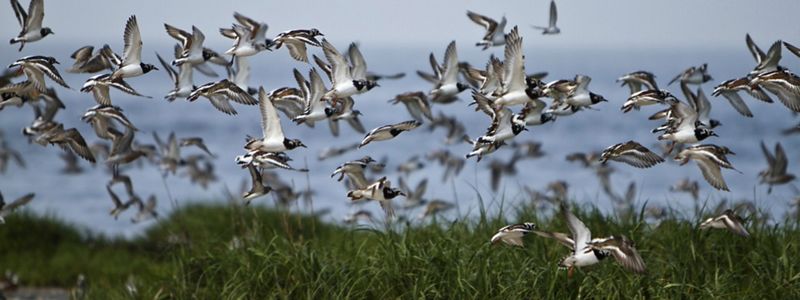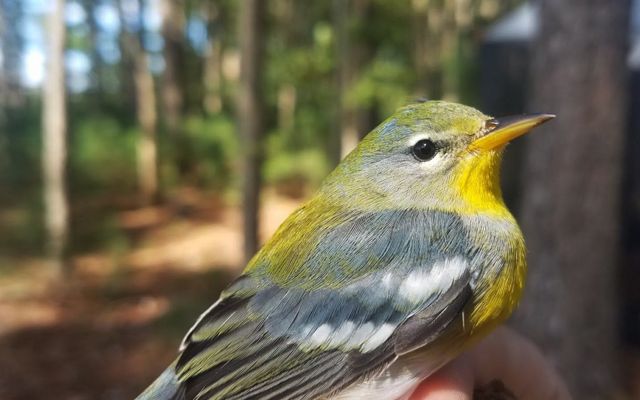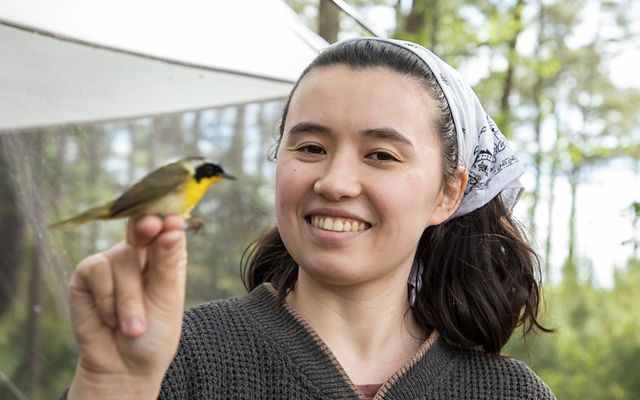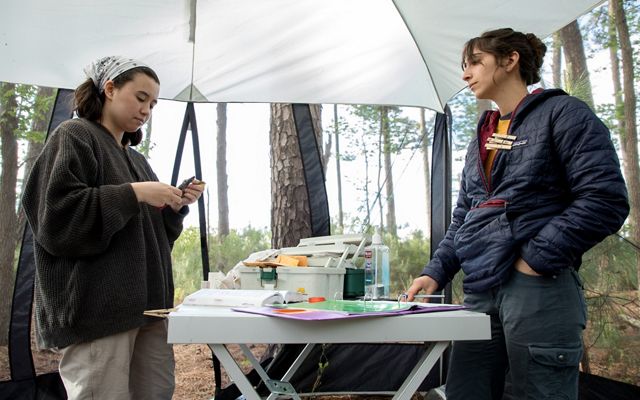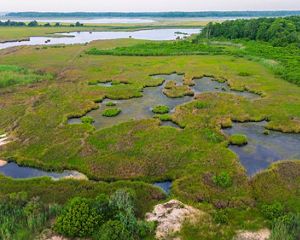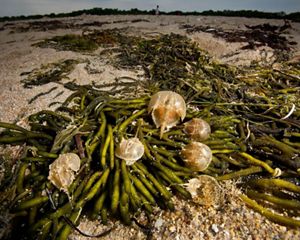Delaware's Melodic Migration
A study at TNC’s Milford Neck Preserve aims to quantify the Delaware Bay's significance as a stopover for migratory songbirds.
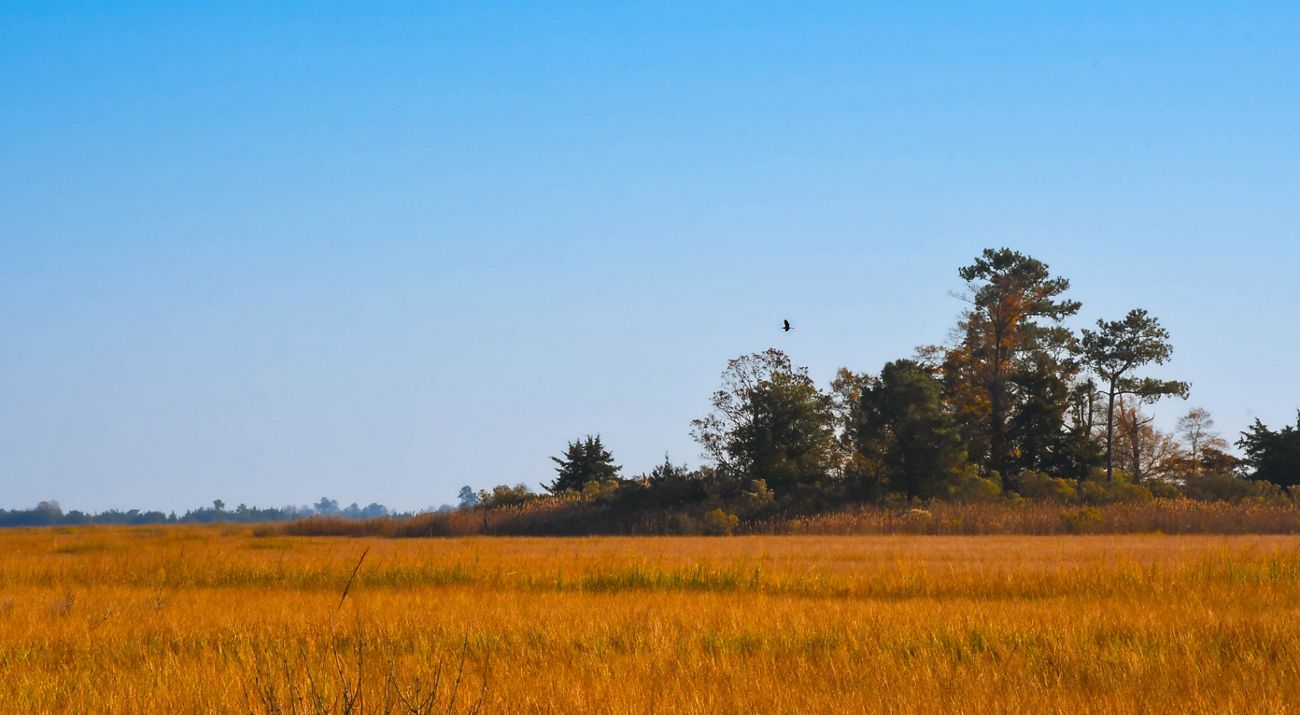
Just a few hundred yards inland from the gentle waves lapping at the shore of the Delaware Bay, loblolly pines grow in the sandy soils next to the salt marsh at The Nature Conservancy’s Milford Neck Preserve. This spot, where the tidal wetlands meet the coastal forest, is the perfect place to study migratory songbirds that stop to feed and rest during their long annual migrations each spring and fall.
Quantifying the Bayshore’s Significance for Birds
A study taking place at our Milford Neck Preserve aims to quantify the importance of the Delaware Bayshore in the life cycle of neotropical migratory songbirds.
Aya Pickett and Tahira Mohyuddin, graduate students at Delaware State University (DSU), set up a net to catch the birds among the thorny greenbrier, bayberry bushes and American holly trees. Pickett and Mohyuddin are working with Dr. Christopher M. Heckscher, professor of environmental science at Delaware State University (DSU), on a study to better quantify the importance of the Delaware Bayshore in the life cycle of neotropical migratory songbirds. The study was funded by NOAA’s Delaware Sea Grant Program administered by the University of Delaware.
“Boreal migrants are of conservation concern considering their recent population declines and the threats they face on their breeding grounds and migratory stopover sites—like the Delaware Bayshore—between boreal and tropical forests,” says Dr. Heckscher.
“To the best of my knowledge, this is the first research project aimed at studying migratory songbird use of Delaware Bay coastal marshes—in New Jersey or Delaware—since 1993 and the first concerted banding effort.”
In addition to collecting important data on migratory birds, this study also aims to assess how sea-level rise could impact the behaviors of bird watchers and other outdoor enthusiasts who visit coastal Delaware.
Birders flock to the Delaware Bayshore to witness the migrations of shorebirds and songbirds that move along the coast with the changing of the seasons, contributing to tourism revenue for coastal communities. Once complete, data from this economic study will be used to help policymakers understand current recreational behavior of bird watchers and other recreationists and how coastal public lands tourism could change under future sea-level rise scenarios.
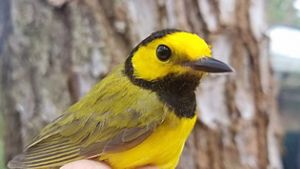

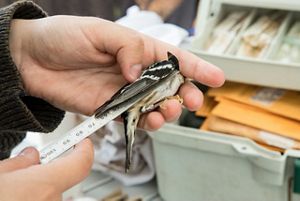
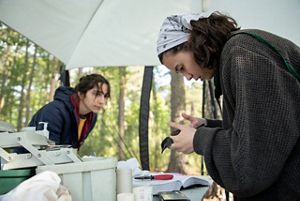


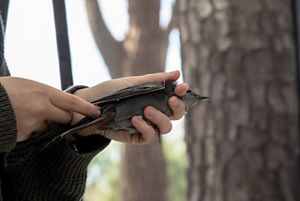

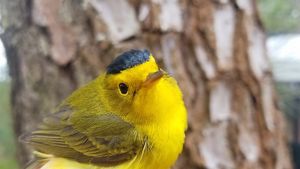
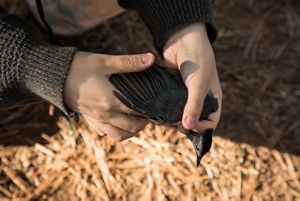

Hooded Warbler: (Setophaga citrina) caught for banding by graduate student Aya Pickett during the Spring 2021 migration at Milford Neck Preserve. © Aya Pickett

Migratory Songbirds: Aya Pickett removes a bird from a mist net, part of a study to quantify the importance of the Delaware Bayshore in the life cycle of neotropical migratory songbirds. © Louis Mason / Louis Mason Photography

Collecting Data: After banding, Aya Pickett measures a Blackpoll warbler (Setophaga striata) prior to releasing it. Part of a study conducted at DE's Mildford Neck Preserve, Spring 2021. © Louis Mason / Louis Mason Photography

Making Observations: Amanda Crandall takes notes as Aya Pickett makes observations of a gray catbird (D. carolinensis), part of a study of the lifecycle of neotropical migratory songbirds in DE. © Louis Mason / Louis Mason Photography

Bird Safety: Birds are safely captured in a mist net and then identified, aged, sexed, weighed and measured. © John Hinkson/TNC

Banding : Birds are carefully banded to help track migration data. © John Hinkson/TNC

Taking a Measurement: Measuring a gray catbird (D. carolinensis) as part of a study to quantify the importance of the Delaware Bayshore in the life cycle of neotropical migratory songbirds. © Louis Mason / Louis Mason Photography

Tools of the Trade: Supplies for banding birds and collecting samples for the Delaware Bayshores neotropical migratory songbird study. Spring 2021. © Louis Mason / Louis Mason Photography

Wilson's Warbler: (Cardellina pusilla) caught for banding by graduate student Aya Pickett during the Spring 2021 migration at Milford Neck Preserve. © Aya Pickett

Collecting Data: Aya Pickett holds a gray catbird (D. carolinensis). The bird will be banded as part of a study to quantify the importance of the Delaware Bayshore to migratory songbirds. © Louis Mason / Louis Mason Photography
Birds are safely captured in a mist net and then identified, aged, sexed, weighed and measured by Pickett and Mohyuddin. Each bird is assigned a standardized muscle and fat score. Before release, a USGS numbered leg band is affixed to each bird for future identification. Pickett and Dr. Heckscher have the required federal and state permits to capture and study these birds.
Mohyuddin and Pickett’s subjective observations will be just as important as the data analysis. Behavioral observations will be used to corroborate the results: frequent observations of birds actively refueling will suggest important use of stopover sites, while infrequent or rare observations will suggest light or non-significant use of resources. After another year of observations and data collection in 2024, Dr. Heckscher will assess the importance of barrier islands, marsh hummocks and nearby woodlands to migratory birds using a variety of quantitative and qualitative means.
The Delaware Bayshore: Critical for Birds of All Kinds
Delaware lies along the Mid-Atlantic Flyway—a major migratory corridor for both north- and southbound transient birds.
Neotropical migratory birds breed in North America—usually the northern U.S. and Canada—during the spring and summer months. Then, during the fall and winter in the northern hemisphere, the birds fly thousands of miles south to Central America, South America or the Caribbean.
Nearly 200 species in North America are considered neotropical migrants, occurring in every habitat and representing 14 different families and subfamilies ranging from songbirds—like thrushes, tanagers and warblers—to shorebirds, some raptors and a few types of waterfowl.
The food sources that neotropical migratory birds rely on to feed their young, such as flying insects, caterpillars, fruits and nectar, are found in abundance in the northern hemisphere during our spring and summer months. But these food sources are not sufficiently available through the cold winter, hence the need to fly south for warmer locales.
Many neotropical migratory songbirds are experiencing long-term population declines, says Dr. Heckscher. He explains that while a variety of causes have been investigated, habitat loss on breeding, wintering and migratory stopover grounds are the primary culprits.
Quote: Dr. Kitt Heckscher
Barrier and near-shore islands and woodlands—like those at TNC’s Milford Neck Preserve—are thought to provide critical habitat for migratory and nesting songbirds and other wildlife.
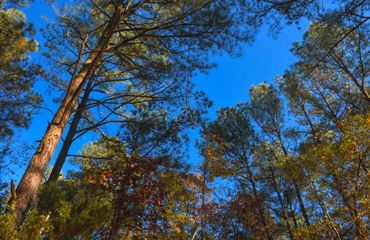
One primary cause of habitat loss is climate change, as rising sea levels are squeezing coastal habitats. Low-lying coastal ecosystems such as salt marshes and barrier islands are particularly vulnerable. Loss or degradation of coastal habitats can have direct effects on songbirds as these habitats are critical for resting, cover and refueling en route to breeding and non-breeding grounds.
“The Delaware Estuary lies along the Mid-Atlantic Flyway—a major migratory corridor for both north- and southbound transient birds including waterfowl, waders, raptors, shorebirds and songbirds,” says Dr. Heckscher.
Quote: DR. KITT HECKSCHER
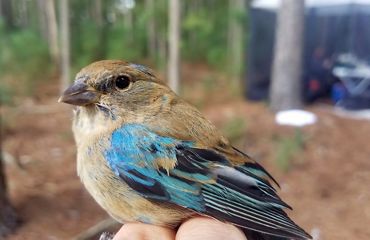
Waterfowl and shorebird migration through the estuary is well known; less known is the migration of millions of songbirds which very likely outnumber the huge concentrations of shorebirds, but their presence is difficult to detect.
The immense concentrations of waterfowl and shorebirds that depend on the estuary’s barrier islands and near-shore habitats are well known, and these migration events draw spectators from around the world resulting in a significant positive effect on Delaware’s local economies.
A study in the 1990s involving several private landowners, along with state and federal agencies, quantified the use of Delaware Bayshore coastal habitats by southbound migratory songbirds. The study found that the Bayshore barrier islands and marsh hummocks are an internationally important coastal resource supporting critical habitat for millions of migratory songbirds.
Surprisingly, no subsequent study has been undertaken to further investigate the ecological importance of near-shore habitats to songbirds, nor has any substantial attention since focused on this landscape. Dr. Heckscher says he’s unaware of any action taken to manage or protect barrier islands and near-shore habitats specifically for songbirds.
The study being overseen by Dr. Heckscher will provide data about the ability of the site at Milford Neck Preserve to provide critical food during the spring and fall migrations, and thus the ecological importance of these habitats. Data will be gathered by assessing the physical condition of birds observed and caught by Pickett and Muyhuddin at the observation station on the edge of the marsh.
“Milford Neck has the largest remaining contiguous coastal forestland along the Delaware Bayshore,” says TNC Land Steward Natasha Whetzel. TNC owns 2,800 acres at Milford Neck and, along with the State of Delaware and Delaware Wild Lands Inc., has collectively protected 10,000 acres and nearly 10 miles of mostly undeveloped beaches, wetlands and coastal forests.
“We know that these protected lands are important for migratory birds—that’s for sure,” says Whetzel. “We’re thrilled that DSU chose to partner with us on this study. It will help us better understand the significance of Milford Neck in this huge global bird migration that happens each spring and fall.”
Economic Welfare Effects of Sea-level Rise on Coastal Recreation in Delaware
Another ongoing study aims to help policymakers understand the current visitation and recreational behavior taking place on coastal public lands.
The economic portion of the study is being led by Dr. Sonja Kolstoe, a former assistant professor of economics at Salisbury University and now a research economist for the USDA Forest Service.
Dr. Kolstoe is working on the project with her undergraduate research assistant Kelsey Poisal of Salisbury University. They are studying the economic effects of sea-level rise on coastal recreation—to include bird watching—in Delaware. Sea-level rise is already altering coastal recreational opportunities in Delaware due to more frequent and prolonged flooding events.
The results of the study can be used to help policymakers understand current recreational behavior to coastal public lands and how that behavior will likely change in the future.
They collected survey data from people in the region to understand coastal public lands visitation for recreational activities like birding, hunting, boating and fishing. Environmental goods and services provide society with ecosystem services (e.g., carbon storage, storm protection, recreational opportunities, etc.) that are not typically bought and sold in a market, referred to as “nonmarket.”
“To make informed policy decisions about coastal public lands, we need to understand the benefits derived from them, to include the nonmarket benefits,” says Dr. Kolstoe. “Travel behavior allows us to measure one part of the total economic value of coastal public lands: the use value for recreation.”
This study will inform end-users, like government and nonprofits, about how economic welfare for visitors to coastal public lands is predicted to change with sea-level rise. This will help decision makers make more informed decisions about managing coastal public lands in the future based on sea-level rise forecasts.
Planning for the Future
Coastal communities will benefit from this research as well—and not just the birders.
As Pickett prepared for another year of observing, catching and banding birds at the Milford Neck Preserve, she wondered if she would re-catch any of the same birds that she banded back in 2020.
“The most common species I caught were myrtle warbler, common yellowthroat and gray catbird,” said Pickett after the fall 2020 migration. “Of all the birds that we captured, my favorites are always the warblers. They are beautiful to look at and can also accomplish some amazing physical feats with their migrations.”
Some of the more colorful birds that were caught at Milford Neck in 2020 include the northern parula, indigo bunting, black-and-white warbler, hooded warbler, Wilson’s warbler, magnolia warbler and the American redstart.
Some of these species, like the Wilson’s warbler whose population is in steep decline, stop in Delaware to refuel on their way to or from breeding grounds in Canada. Other birds like the American redstart and the hooded warbler may spend the summer here along the Delaware Bayshore, laying eggs and raising their young before heading south in the fall.
In one seven-year study in Pennsylvania, approximately 50% of banded male hooded warblers returned to the same area to breed again. Is the same true for similar neotropical migratory songbirds that breed in Delaware? This research project will help get us one step closer to finding out.
Coastal communities will benefit from this research as well—and not just the birders. After completion of the studies, a workshop with stakeholders will take place to present findings and discuss protection and restoration needs. The information will be available for use by academics, nonprofits and government agencies to help plan future land protection efforts and make the best use of places that have already been protected.
“This study is providing the ornithological world with important data collected for the first time,” says Dr. Heckscher. “Soon we will have a clear picture of the Bayshore’s place in the global migrations of millions of songbirds. We’re eager to see what we learn this year—it’s exciting to be part of a multi-faceted study. This partnership with Delaware State University, Salisbury University, the USDA Forest Service, Delaware Sea Grant and The Nature Conservancy is a great example of people from different sectors working together for the benefit of people and wildlife. And there’s no better subject to bring people together than birds."
See for Yourself: Birdwatching Guide
The best places and times to catch a glimpse of some of these colorful, transient birds.
Are you interested in catching a glimpse at these colorful, transient birds during their migrations? The best time to view these migratory songbirds along the Delaware Bayshore is from May to early June and then again in September and early October.
While TNC’s Milford Neck Preserve is not publicly accessible, we highly recommend visiting the nearby Prime Hook National Wildlife Refuge located about 10 miles south of Milford Neck. Prime Hook is approximately a 30-minute drive north of Lewes and Rehoboth Beach.
Bombay Hook National Wildlife Refuge, located northeast of Dover, is a birder’s paradise year-round. It offers several elevated platforms for bird watching that are great for spotting migratory songbirds that spend lots of time among the treetops. Numerous other public lands along the Delaware Bayshore—especially those to the east of Route 9—offer remarkable settings for bird watching and soaking up nature.
Visitors to TNC’s Edward H. McCabe Preserve and the Ponders Tract at Pemberton Forest Preserve will also see some of these birds during the migrations. These preserves are both located several miles inland from the Delaware Bay, so the birds will not be present in the same numbers that you will see closer to the coast. TNC’s public preserves in Delaware are free to visit—another great reason to get out there and enjoy nature.
Interested in More Birdwatching?
Check out our birdwatching guide to discover the best spots for observing unique feathered species in Delaware and Pennsylvania, all year round.

This study is in progress and is primarily funded through a Delaware Sea Grant and also supported in part by the USDA Forest Service. The views expressed within the article are those of the author and researchers who are involved in this study and they should not be construed to represent any official USDA or U.S. Government determination or policy.
Stay in Touch
Sign up to receive email monthly conservation news and updates from Delaware.
